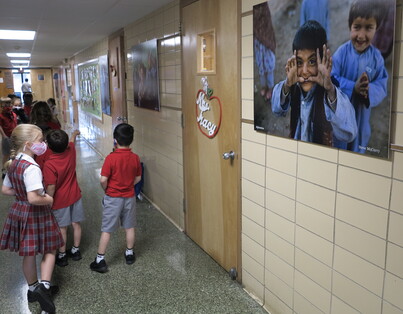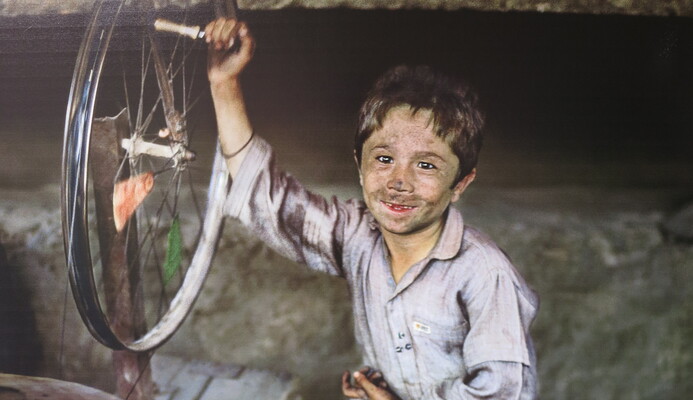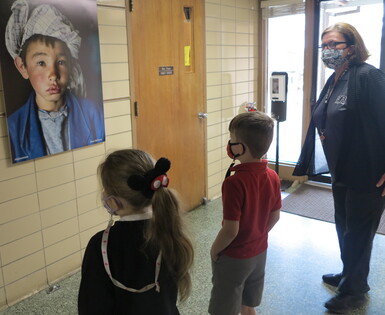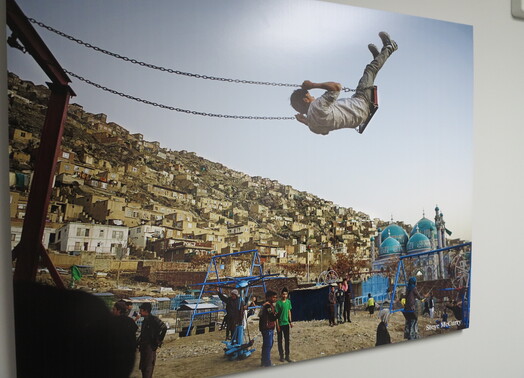
A platform that encourages healthy conversation, spiritual support, growth and fellowship

NOLACatholic Parenting Podcast
A natural progression of our weekly column in the Clarion Herald and blog

The best in Catholic news and inspiration - wherever you are!
St. Rosalie School hosts world-class photo exhibit
-
Above: A boy in Afghanistan tackles a job familiar to children around the world: fixing a bike tire. (All photos by Steve McCurry, courtesy of the Besharat Foundation)
Each of us is a unique member of one human family.
By BETH DONZE
Clarion Herald
That’s the overriding message of a remarkable new exhibit of photographs at St. Rosalie School in Harvey entitled “The Faces of Innocence,” a series of 50 full-color, globe-spanning images of children taken by National Geographic photographer Steve McCurry.Blown up onto 30-by-40-inch boards and mounted throughout St. Rosalie’s campus, McCurry’s stunning images show children at play, school, work, worship and family life in more than a dozen countries, including Cambodia, Afghanistan, China, Bangladesh, Vietnam, Ethiopia, Tibet, Cuba and Madagascar.
“I’ve seen our children gasping and saying look at that!” said Caren Creppel, St. Rosalie’s principal and a seventh-grade religion teacher. “When I’m taking students down the hallway, I hear them asking, ‘Why are their houses like that?’ and ‘Where was this (photo) taken?’”
St. Rosalie is the first Catholic school in the New Orleans area and one of more than 50 schools in the United States and France to host the “Faces of Innocence” exhibit. The current display is the first of four installments that will unfold at St. Rosalie over the next several years through the “Art in School” project conceived by the Atlanta-based Besharat Arts Foundation. The foundation’s leader, Massoud Besharat, created Art in School in the hope that daily contact with McCurry's poignant photos would foster empathy among children of all nations by showcasing the many things they have in common – playtime, love for family life, etc. – while celebrating those cultural differences that make the world interesting.
Photos foster fellowship among children
Many of the images capture children’s inherent pride, joy and sense of fun. For example, an Afghan boy holds his hands to his face as though he is holding a camera, playfully mimicking the photographer taking his picture; a young girl from the West African nation of Benin carries a prized stuffed animal on her back; and boys make use of a wall to do leg stretches during a P.E. class in China.
Although the exhibit doesn’t overly focus on the traumas endured by children, it does include some sobering images, such as the mother and son from Cambodia who nap as a snake slithers beneath their hammock; and the Tibetan boy selling Swiss chard, presumably to earn extra money for his family.
The exhibit, which was delivered to campus and mounted by the Besharat Foundation at no cost to the school, came to St. Rosalie after religion coordinator Guyann Murphy learned of the program from a friend.
Interdisciplinary catalyst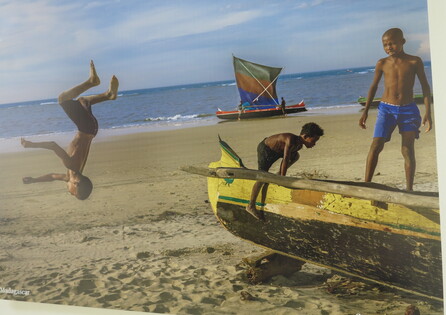 In addition to ha
In addition to having the thrill of seeing their campus become an art gallery, St. Rosalie students, under the guidance of their teachers, already are using the photos as a springboard for thought-provoking, age-appropriate assignments in religion, social studies, science, English and art.
“This will increase their observation and interpretive skills, help them develop an awareness of historical context and develop critical thinking skills," Creppel said.
For example, kindergartners were challenged to draw a picture of how their own classroom differed from the foreign classrooms featured in the exhibit.
Murphy, who also teaches social studies, is taking her seventh graders to one section of the exhibit at a time, so they can better absorb the images and incorporate their thoughts into written reflections.
“I had them walk around (one part of the exhibit) in complete silence and asked them to choose one photo that spoke to them,” said Murphy, who asked her students some questions that they could fold into their essays: What did you choose this photo? What does the photographer want you to feel? How do you feel looking at it? If this photo had been taken in the United States, how would it be different? If you could speak to the children in the photo, what would you say to them? What title would you give the photo?
Seventh grader Brianna Teran chose McCurry’s powerful portrait of a girl at a refugee camp in Pakistan. The image was part of a photo shoot that went on to be featured in one of National Geographic’s most iconic issues.
“The girl is covering most of her face to show her green eyes,” Brianna observed. “I think the photographer wanted us to think and feel that anything and everything is beautiful, no matter what the state or conditions are.”
After studying a photo of a boy who had been rescued from a fire unharmed, seventh grader Dalayna Porter said it made her “realize how bad it really is in some countries, how kids suffer. I feel sad, guilty, lucky and grateful at the same time.”
Creppel said fostering empathy is a daily mission of Catholic education, which teaches the students in its care that every human being is a beloved son or daughter of God, created in God’s image and likeness.
On a more practical note, Creppel said the exhibit gives her school families and other visitors an opportunity to “travel” the world. Her hope is that families will dust off their home globes and research countries they might only have heard about during the Olympics – places such as Burma and Mauritius.“When we go on vacation, we might go to the beach or to Disney World, but who has the chance to go to some of these countries (pictured in the exhibit)?” Creppel asked. “This is an opportunity to open up their world!"
The exhibit is free and open to the public at St. Rosalie School, 617 2nd Ave., Harvey, from 3:30-6 p.m. on Tuesday, May 11; Thursday, May 13; Tuesday, May 18; and Thursday, May 20. Weekend viewing hours are also available to the public and are provided as an added convenience for those attending Mass at St. Rosalie Church, just steps from the school. Weekend hours are: Saturday, May 8, 1-3:30 p.m.; Saturday, May 15, 5-7 p.m.; Sunday, May 16, noon-2 p.m.; Saturday, May 22, noon-3 p.m.; and Sunday, May 23, noon- 2 p.m. In accordance with COVID-19 protocols, visitors must sign in upon entry and wear a face mask while inside the school building.
[email protected]
